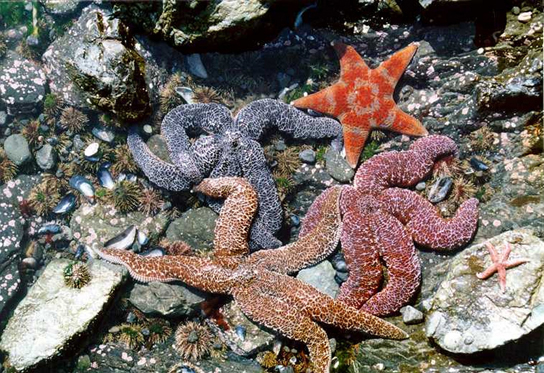| << Chapter < Page | Chapter >> Page > |
The physical diversity of the ocean is a significant influence on plants, animals, and other organisms. The ocean is categorized into different zones based on how far light reaches into the water. Each zone has a distinct group of species adapted to the biotic and abiotic conditions particular to that zone.
The intertidal zone , which is the zone between high and low tide, is the oceanic region that is closest to land ( [link] ). Generally, most people think of this portion of the ocean as a sandy beach. In some cases, the intertidal zone is indeed a sandy beach, but it can also be rocky or muddy. The intertidal zone is an extremely variable environment because of tides. Organisms are exposed to air and sunlight at low tide and are underwater most of the time, especially during high tide. Therefore, living things that thrive in the intertidal zone are adapted to being dry for long periods of time. The shore of the intertidal zone is also repeatedly struck by waves, and the organisms found there are adapted to withstand damage from the pounding action of the waves ( [link] ). The exoskeletons of shoreline crustaceans (such as the shore crab, Carcinus maenas ) are tough and protect them from desiccation (drying out) and wave damage. Another consequence of the pounding waves is that few algae and plants establish themselves in the constantly moving rocks, sand, or mud.

The neritic zone ( [link] ) extends from the intertidal zone to depths of about 200 m (or 650 ft) at the edge of the continental shelf. Since light can penetrate this depth, photosynthesis can occur in the neritic zone. The water here contains silt and is well-oxygenated, low in pressure, and stable in temperature. Phytoplankton and floating Sargassum (a type of free-floating marine seaweed) provide a habitat for some sea life found in the neritic zone. Zooplankton, protists, small fishes, and shrimp are found in the neritic zone and are the base of the food chain for most of the world’s fisheries.
Beyond the neritic zone is the open ocean area known as the oceanic zone ( [link] ). Within the oceanic zone there is thermal stratification where warm and cold waters mix because of ocean currents. Abundant plankton serve as the base of the food chain for larger animals such as whales and dolphins. Nutrients are scarce and this is a relatively less productive part of the marine biome. When photosynthetic organisms and the protists and animals that feed on them die, their bodies fall to the bottom of the ocean where they remain; unlike freshwater lakes, the open ocean lacks a process for bringing the organic nutrients back up to the surface. The majority of organisms in the aphotic zone include sea cucumbers (phylum Echinodermata) and other organisms that survive on the nutrients contained in the dead bodies of organisms in the photic zone.
Beneath the pelagic zone is the benthic realm, the deepwater region beyond the continental shelf ( [link] ). The bottom of the benthic realm is comprised of sand, silt, and dead organisms. Temperature decreases, remaining above freezing, as water depth increases. This is a nutrient-rich portion of the ocean because of the dead organisms that fall from the upper layers of the ocean. Because of this high level of nutrients, a diversity of fungi, sponges, sea anemones, marine worms, sea stars, fishes, and bacteria exist.

Notification Switch
Would you like to follow the 'Biology' conversation and receive update notifications?